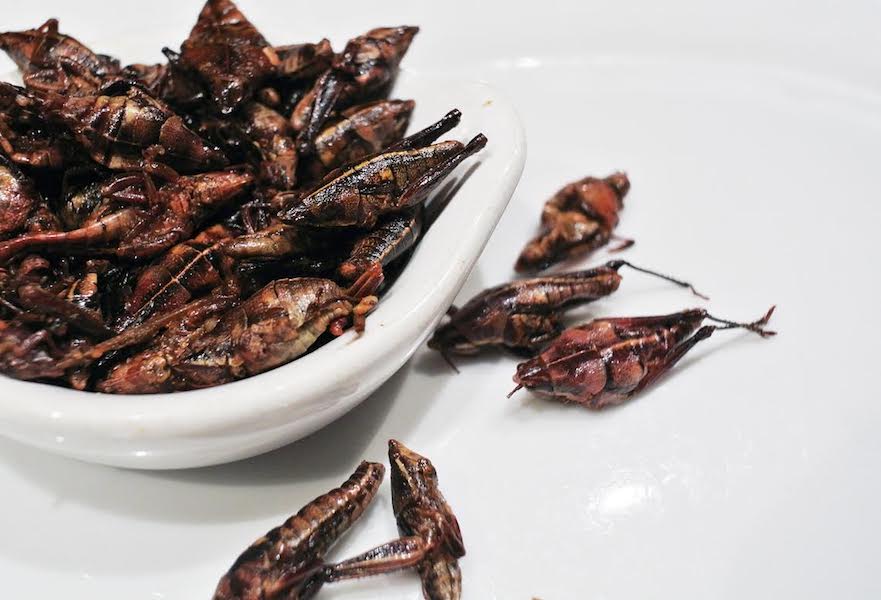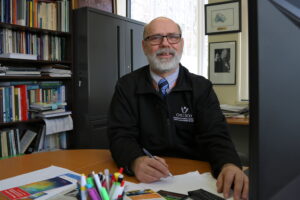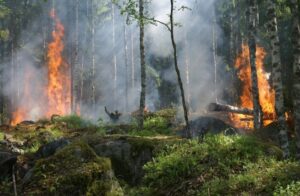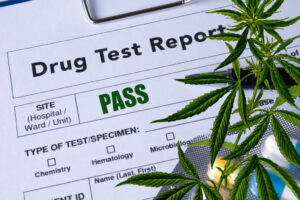Baseball has been around for almost 200 years, but even its long-held snacking traditions are shifting in the face of new consumer appetites. The high-fructose corn syrup Crackerjacks are out, but safe at first is a delightful bowl of locally grown organic grasshoppers. The Seattle Mariners introduced chapulines at their concessions in 2017, and the nutritious, crunchy snack has proven to be a hit. Not only are they tasty with a bit of chilli-lime salt, grasshoppers are an environmentally friendly food choice in a world where food sustainability is an ever-growing concern.
Those famous beef hot dogs promoted up and down the stadium aisles require an incredible 10 Megajoules of energy to raise, feed and transport before becoming the launching pad for that embarrassing mustard spill on your new Felix Hernandez jersey. Grasshoppers, however, do not require much energy, land or infrastructure compared to other alternatives like livestock. In fact, if the folks at Safeco field wanted to source an especially local variety, they probably have all the space and grass required to raise a crop out in left field.
Consumers are becoming increasingly aware that the food choices they are making are having an impact on both the environment and local ecology. Forests around the world are cleared to make way for energy-intensive ranching, and great quantities of fossil fuels that are consumed to ship produce from suppliers to customers. In the face of global climate change, new options are being sought after by conscientious consumers. Some of those options include selecting less energy intensive protein sources, increasing the proportion of fresh vegetables in their diet and eating more food produced locally.
Vancouverites do seem to have an inclination to spend a bit extra for the local or organic options available to them, as demonstrated by the popularity of high-end grocery stores and smoothie bars, but despite the inclination to do so, how feasible is it for members of our community to consistently find sustainable food options?
Authors J. B MacKinnon and Alisa Smith wrote a book in 2007, The 100-Mile Diet: A Year of Local Eating, in which they explore this complex issue. The Vancouver based couple learned that the average ingredient in a North American diet travels 1,500 miles from farm to plate, and amazed by this fact they embarked on an investigation into food sourcing.
For one year, they only consumed food that was produced within a 100-mile radius of their home (approximately the distance from the coast to Hope).

During this experiment, they learned a lot about seasonal produce and fish sources, struggled with the supply of staple items (like flour), and experienced pressures of social influences to accommodate. The local sourcing of food supplies (a.k.a a locavore diet) proved to be challenging, but certainly feasible in their estimation.
Since the time of their experiment, Vancouver has grown, become more environmentally aware and the city’s municipality has expanded its support for infrastructure into local food sources. Vancouverites have no doubt noticed a growth in the number of community gardens throughout the city. At last count, Vancouver has over 110 community gardens in city parks, in schoolyards, and on private property. This is still a far stretch, however, from the amount of food needed to sustain a population of our city’s size, which StatsCanada’s last census counted at just over 2.2 million people in the greater Vancouver area.
In order to grow enough food for a population that size, the BC ministry of agriculture estimates about half an acre of farmland is needed per person per year. Eager to raise its profile as one of North America’s greenest communities, the City of Vancouver supports and promotes the distribution of local food resources through programs like the community gardens in order to connect consumers and growers. According to vancouver.ca:
“Eating locally grown food reduces your ecological footprint, decreases waste from packaging, and eases concerns about food safety. Local food is also fresher, more nutritious, and better tasting.”
While these benefits appear evident, there are a number of factors that limit local food production to small-scale endeavours. Land costs are certainly an important constraint, and in a city full of million dollar land plots, there are not many places to create a financially viable urban farm.

One place in the city where you can find a farm, however, is at UBC. There, researchers from several faculties are getting their hands dirty trying to find methods of producing food more sustainably.
“When you think about food systems, lots of people think about farming and retail considerations, and we do too, but we also look at broader issues like access to land, ecosystem services and how food cultivation and gathering sits with the biocultural landscape of sustainable and equitable land and food relations”, said Dr. Hannah Wittman, academic director at UBC Farm and Associate Professor at the Institute for Resources, Environment and Sustainability at the University of British Columbia.
Thus, it appears the question of ‘is it feasible to live sustainably?‘ really depends on what each person’s definition of sustainability is. There is more to sustainability than whether the food source is local; the consideration to purchase organically cultivated food is also of great interest to consumers, but then again human rights may be of bigger concern to you. With so many factors to consider, how feasible is sustainability practices really for the average Vancouverite? A lot of it comes down to personal choice; the battles you choose and the practices you support should be reflective of decision you are comfortable with.
“The bottom line is about relationships. What understanding do you have about the origins of your food? Speaking from a consumer perspective, I understand the origins of Bananas, I feel quite comfortable with my choice in eating fair trade and organic bananas, but I’ll also prefer to purchase BC apples over imported ones. Some of it has to do with how those apples are produced and some of it has to do with how I know those farm workers are treated, some of it is I like the taste of BC apples. So it is a lot of information that goes into what a consumer values about their food and then they can structure their choices”, commented Dr. Wittman.

If we focus on the question of sustainability on what is locally available, the situation is still tricky, because really what is considered local? Is it a 100 miles, 500 miles, or is it provincially or maybe is it Canadian grown? So even the definition of local is highly contested. A lot of what we consider locally also has nothing to do with where food is grown but where it is processed. For example, coffee beans can be imported but roasted locally and still considered a locally sourced. The UBC Farm takes their research one step further, and looks offshore.
“We don’t just think about land; we need to consider the ocean, as the marine-based food economy is important to this bioregion”, explained Dr. Wittman “Our seafood is threatened by land-based activities including agriculture, and policies related to marine harvesting.”
It comes down to this, what balance between local food production and food trade makes sense. The ministry of agriculture over a decade ago started to look at how much farmland would be needed to feed British Columbia. We have the Agricultural Land Reserve and basically, we have more than enough land in B.C. on a per person basis to feed everybody. However, if you look at what people actually want to eat here; there are bananas in the winter, we drink coffee, and avocados have become central many a Canadian’s diet.

Another problem we face in Vancouver is that the best agricultural land within the lower mainland may actually be going to other development projects, like housing. Meaning the food that could be grown closer to home, and as such have a lesser transportation footprint, is not getting the space to do so.
Essentially living sustainably is difficult and takes planning, but there are people that manage it. More so there are even businesses that manage it. The Acorn is one such business; the restaurant has been in business for five and half years and strives to obtain most of their supplies from the lower mainland area. Owner and founder of The Acorn, Shira Blustein, says times have changed and it is easier now to source locally than five years ago.
“Accessibility has definitely improved a lot. There is a farmers market close to the restaurant, which is basically available all year round now to some degree, this is huge. Availability and interest has gone up” commented Shira Blustein.
For their part, they have their own garden to pull from and have relationships with several local suppliers, but they are fortunate and can adapt their menu to meet their standards. For most chain restaurants with set menus, it is difficult.
“The problem is consistency”, explained Shira Blustein, “you have to have flexibility in your menu, and not all restaurants want to do that many like to find a menu that works for them and stick with that and if need something, like tomatoes, that are seasonal that can be difficult.”
And how does someone running a business like The Acorn decide on how to operate sustainably?
“It is not a financial choice but I do think about the good it does locally even something as simple as supporting local labour, I feel I am contributing to the greater good. Additionally, health-wise, all the farms we work with grow things organically, and that is something I feel good about”, described Shira Blustein.
So if a business can be run on sustainable practices then the average family should be able to take steps to living more sustainably as well, it is just a matter of figuring out what sustainably means to you. The first thing to tackle is information. Learning more about the origins of your food source and how they are produced will go a long way to helping you make a decision you can live with. As for some practical steps, choose organic produce and be mindful of waste production by composting and participating in the city’s green bin program for food scraps collection.
The fact that more local food sources are available in Vancouver is a reflection of the demand created by consumers. Thus supporting those commercial entities that provide your source of sustainable food will encourage availability. Farming practices can always improve to lessen their environmental footprint but this to will be adapted faster with society’s support.
“Farmers in the valley are managing a lot of land and they are doing that for the benefit of our food production. Does this mean we need to pay more for some of our food? Sometimes yes. It also means the government can act to protect the environment by supporting solutions to sustainable land management transitions” described Dr. Wittman.
Food systems are complicated and with so many angles to study research organizations like UBC have their work cut out for them. Some projects on their horizon to look forward to include improve methods for more sustainable pest management, using peppermint to control pest in the blueberry sector, and they are working on ways to use agriculture to mitigate climate change.









